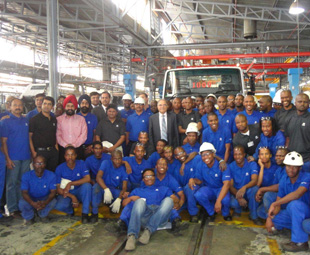Tata targets a ten-fold production increase

Tata is showing no sign of resting on its laurels after producing its 1 000th truck shortly after the first birthday of its Rosslyn plant. Raman Dhawan, MD of Tata Motors Africa, told FOCUS yesterday that the achievement seems to have boosted morale and that we can expect to see even higher production volumes from this manufacturer in the coming year.
Commenting on the production milestone achieved on October 25, Dhawan said: “We have always strived to surpass the set standards of excellence as we aim for our targets. Innovation must run in our veins as we work toward being increasingly competitive. Our workers have shown that this is possible.”
Dhawan acknowledged the significance of thie team behind the achievement: “I would like to thank workers for surpassing set targets while additionally recognising the stringent ISO 9001 quality assurance standards they have had to adhere to with each truck.”
Dhawan has now urged the team to work towards assembling 10 000 vehicles within the next two years. “This is a target which, if met, will ensure expansion for the plant. After all, it [the plant] has a current annualised capacity of assembling 3 650 vehicles.”
Dhawan feels however, that in aiming for volume, it’s important for the team not to lose sight of the big-picture goals of the company: “We will not digress from our initial aspirations of growing the assembly plant into a more competitive manufacturing facility with an increasing percentage of parts sourced locally.”
The Rosslyn plant is Tata Motors’ first major assembly plant outside of India. It reflects commitment to the group’s growth strategy, which aims to increase the manufacturing capacity of the automotive industry in South Africa.
The plant was opened in July 2011 by the Minister of Trade and Industry, Dr Rob Davies, who attributed the R110 million venture in part to South Africa’s investment-friendly policies. At the time of the opening, government had begun aggressively pursuing an industrial development strategy for the South African medium and heavy commercial vehicle (MHCV) sector.
“The key focus area of the MHCV strategy is based on support for market development and this means local and regional,” said Davies. “Industry role players have been, and still are, part of the extensive consultation process that accompanies the development of such a strategy. This will be an opportunity for further expansion of Tata Motors in South Africa.”
The Tata Automobile Corporation entered the South African automobile market in 1998 and has been a strong competitor in its market segments since 2004 when the Indica and Indigo passenger cars and utility vehicles were introduced. Today, a network of 32 Tata dealerships distributes commercial and passenger vehicles throughout South Africa.
Published by
Focus on Transport
focusmagsa




 Big news from FOCUS on Transport + Logist
Big news from FOCUS on Transport + Logist


 !
Starting 1 April, every
!
Starting 1 April, every


 FUSO: Driving the Future of Mobile Healthc
FUSO: Driving the Future of Mobile Healthc



 A brand
A brand




 Wondering about the maximum legal load for a
Wondering about the maximum legal load for a 
 The MAN hTGX powered by a hydrogen combus
The MAN hTGX powered by a hydrogen combus

 Exciting News for South African Operators
Exciting News for South African Operators


